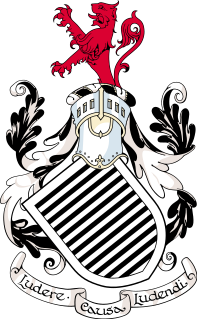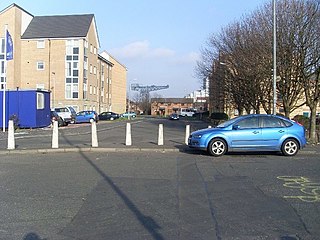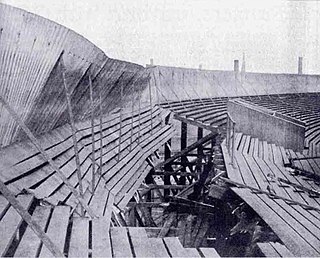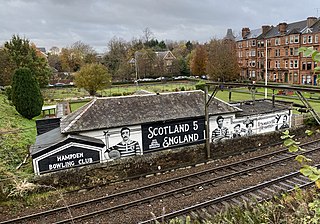Related Research Articles

Rangers Football Club is a Scottish professional football club based in the Govan district of Glasgow which plays in the Scottish Premiership. Although not its official name, it is often referred to as Glasgow Rangers outside the UK. The fourth-oldest football club in Scotland, Rangers was founded by four teenage boys as they walked through West End Park in March 1872 where they discussed the idea of forming a football club, and played its first match against the now defunct Callander at the Fleshers' Haugh area of Glasgow Green in May of the same year. Rangers' home ground, Ibrox Stadium, which was designed by stadia architect Archibald Leitch and opened in 1929, is a Category B listed building and the third-largest football stadium in Scotland. The club has played in royal blue shirts for the entirety of its history.

Queen's Park Football Club is a Scottish professional football club based in Glasgow, which currently plays in Scottish League One, the third tier of the Scottish football pyramid. Queen's Park is the oldest association football club in Scotland, having been founded in 1867, and is the oldest in the world outside England and Wales.

Ibrox Stadium is a football stadium on the south side of the River Clyde in the Ibrox area of Glasgow, Scotland. The home of Rangers Football Club, Ibrox is the third largest football stadium in Scotland, with an all-seated capacity of 50,817.

Hampden Park is a football stadium in the Mount Florida area of Glasgow, Scotland. The 51,866-capacity venue serves as the national stadium of football in Scotland. It is the normal home venue of the Scotland national football team and was the home of club side Queen's Park for over a century. Hampden regularly hosts the latter stages of the Scottish Cup and Scottish League Cup competitions and has also been used for music concerts and other sporting events, such as when it was reconfigured as an athletics stadium for the 2014 Commonwealth Games.

Kinning Park is a southern suburb of Glasgow, Scotland. It was formerly a separate police burgh between 1871 and 1905 before being absorbed by the city. In 1897, it had a population of 14,326.
Clydesdale Cricket Club is a sporting club situated at Titwood on the periphery of Pollokshields in the south of Glasgow.

Hampden Park in Glasgow is the primary home stadium for the Scotland national football team. This has been the case since 1906, soon after it opened. The present site of Hampden Park is the third location to bear that name and both the previous locations also hosted Scotland games. Scotland have also played many of their home games in other stadiums throughout their history, both in friendly matches and for competitive tournaments.
Clydesdale F.C. were a nineteenth-century Glasgow-based football club, who were attached to Clydesdale Cricket Club during the 1870s. In 1873, Clydesdale was one of the teams to found the Scottish Football Association.

Scotland was one of the earliest modern footballing nations, with Glasgow club Queen's Park early pioneers of the game throughout the UK. More clubs formed in Scotland, resulting in the commencement of the first major competition in 1873, the Scottish Cup, then the founding of the Scottish Football League in 1890. With the official sanctioning of professionalism, the Old Firm of Celtic and Rangers became dominant in Scotland, and remain so, although other clubs have enjoyed brief periods of success too.
Titwood is a cricket ground in the Pollokshields area of Glasgow, Scotland. It is the home of the Clydesdale Cricket Club and is one of four international grounds in Scotland approved by the International Cricket Council (ICC) as a home venue for the Scotland national cricket team.

The 1873–74 Scottish Cup – officially the Scottish Football Association Challenge Cup – was the first season of Scotland's most prestigious football knockout competition. A total of 16 teams from the west of Scotland entered the competition, however only 14 would play a match after two withdrawals. The competition began on 18 October 1873 and concluded with the final on 21 March 1874. The inaugural cup was won by Queen's Park who defeated fellow Glasgow club Clydesdale 2–0 in the final.

The 1902 Ibrox disaster was the collapse of a stand at Ibrox Park in Govan, Scotland. The incident led to the deaths of 25 supporters and injuries to 500 more during an international association football match between Scotland and England on 5 April 1902 as part of the 1901–02 British Home Championship.
The Football World Championship, also known as the United Kingdom Championship or the International Club Championship, was a friendly association football match played between the English and Scottish club champions on a regular, but not annual, basis in the late 19th and early 20th centuries, with varying degrees of press attention and public interest. Perhaps the most widely publicised at the time under the 'World Championship' name was the 1888 event between Renton and West Bromwich Albion, while in the modern age interest from historians has drawn more attention to matches involving Sunderland, particularly the 1895 match.

Hampden Park was a football ground in Glasgow, Scotland. The home ground of Queen's Park from 1873 until 1883, it was the first of three stadiums to bear the same name, and hosted the first-ever Scottish Cup final in 1874.
Ibrox Park was a football ground in Ibrox, Scotland. It was the home ground of Rangers from 1887 until they moved to the adjacent second Ibrox in 1899. The ground staged the Scottish Cup Final four times and also three Scotland international matches.

From 1870 to the present day, the Scotland national football team have played various matches that are not accorded the status of official (FIFA) internationals by the governing body, the Scottish Football Association. These include early matches against England prior to the first-ever official international in 1872, wartime fixtures between 1914–1919 and 1939–1946 when official competitions were suspended, overseas tour matches played by a Scotland XI of varying strength and status, and others as specified.

Founded in 1883, the Glasgow Football Association, based in the city of Glasgow, Scotland and affiliated to the national Scottish Football Association, is one of the oldest such bodies in football. In the modern game its influence is limited, the remit being "to represent the interests of the senior football clubs in Glasgow". Those senior clubs competing across the divisions in the Scottish Professional Football League include the two largest and most successful in the country by some distance, Celtic and Rangers, as well as Partick Thistle, Queen's Park and Clyde ; the three smaller clubs exist in the shadow of their dominant neighbours. A sixth team, Third Lanark, had a strong record until their sudden collapse in the mid 1960s.
Burnbank Park was a sports ground in Glasgow, Scotland. It was situated in the city's Woodlands area, found at Barrington Drive. No trace of the ground remains, having been built on by sandstone tenement housing in the late 19th century, which survives into the 21st century. The name endures locally with the Burnbank Bowling Club a few blocks to the south, founded in 1866, around the same time the sports grounds were coming into use for team sports.
Parkgrove F.C. were a nineteenth-century Glasgow-based senior football club. They were based in Govan, Glasgow.
References
- ↑ O'Brien, p.174
- 1 2 3 "Historical Milestones" (pdf). Clydesdale Cricket Club. Retrieved 14 November 2020.
- ↑ "The great cricket match in Glasgow. Scotland versus England" . The Glasgow Herald. 12 September 1851. p. 8. Retrieved 14 November 2020– via British Newspaper Archive.
- ↑ "Glasgow v All England XI" . CricketArchive. Retrieved 14 November 2020.
- ↑ "Miscellaneous matches played on Kinning Park, Glasgow" . CricketArchive. Retrieved 14 November 2020.
- ↑ "Mid-On" (24 April 1893). "Cricket notes" . The Scottish Referee. Glasgow. p. 2. Retrieved 14 November 2020– via British Newspaper Archive.
- ↑ "Football" . The Scotsman. Edinburgh. p. 7. Retrieved 14 November 2020– via British Newspaper Archive.
- ↑ "Great football match at Glasgow" . Sheffield and Rotherham Independent. 3 April 1876. p. 4. Retrieved 14 November 2020– via British Newspaper Archive.
- ↑ O'Brien, p.33
- ↑ O'Brien, p.173
- 1 2 3 "Kinning Park". The Founders Trail. Retrieved 14 November 2020.
- ↑ "Saturday's football matches" . The Edinburgh Evening News. 28 March 1881. p. 4. Retrieved 14 November 2020– via British Newspaper Archive.
- ↑ "Football" . The Greenock Advertiser. 28 March 1881. p. 3. Retrieved 14 November 2020– via British Newspaper Archive.
- ↑ "Scottish Football Challenge Cup - protest" . The Evening News and Star. Glasgow. 30 March 1881. p. 4. Retrieved 14 November 2020– via British Newspaper Archive.
- ↑ "Football Association Challenge Cup" . The Glasgow Herald. 11 April 1881. p. 10. Retrieved 14 November 2020– via British Newspaper Archive.
- ↑ "Studmarks" . The Coatbridge Express. 1 October 1941. p. 4. Retrieved 14 November 2020– via British Newspaper Archive.
- ↑ "Saturday's football" . The Glasgow Herald. 21 February 1887. p. 8. Retrieved 14 November 2020– via British Newspaper Archive.
- ↑ "Track & (Football) Field". Scottish Athletics. Retrieved 19 November 2020.
- ↑ "Our Scotch Letter" . The Athletic News and Cyclists' Journal. Manchester. 9 June 1885. p. 5. Retrieved 19 November 2020– via British Newspaper Archive.
- Sources
O'Brien, Ged (2010). Inglis, Simon (ed.). Played in Glasgow: Charting the Heritage of a City at Play. London: Malavan Media. ISBN 9780954744557.